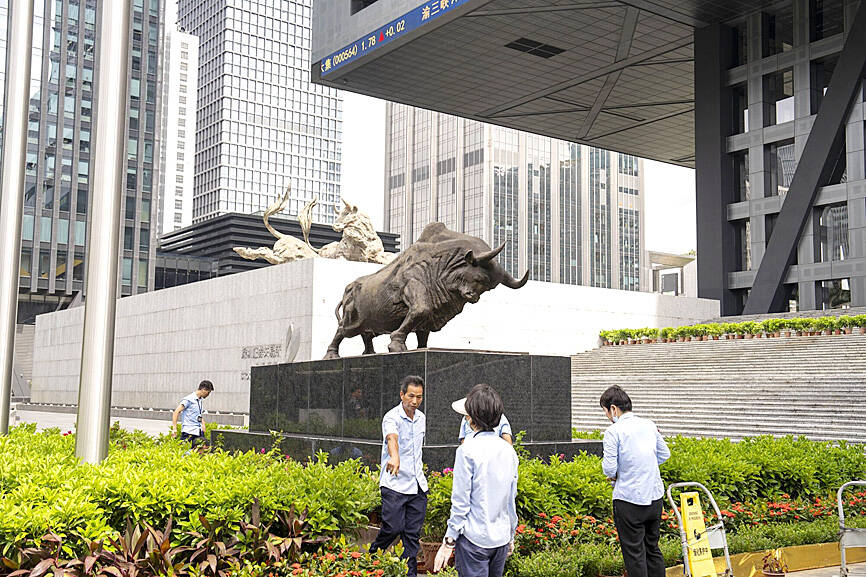China might see its first yearly outflow from equities this year — but if and when it happens, investors would not know from exchange data.
That is because the country’s stock exchanges would stop releasing daily data on overseas fund flows starting today, depriving investors of a key sentiment indicator to track the US$8.3 trillion market.
The change, first hinted at in April, comes as foreign funds have steadily withdrawn from the market, taking the year-to-date tally to negative as of Friday.

Photo: Raul Ariano, Bloomberg
Analysts saw the move as another effort by authorities to prop up the market, hoping to reduce volatility induced by high-frequency data and turn investor focus to longer-term indicators.
“Beijing stopped the release, because the data hasn’t been looking good, and it’s volatile,” abrdn Asia Ltd investment director Ng Xin-yao (黃新耀) said.
“They probably don’t want the data to amplify capital outflows,” but “it doesn’t solve the root of the problem,” he added.
If the selling persists, China might see the first annual outflow from its stock market since 2016, when Bloomberg began tracking purchases through the trading links with Hong Kong.
With the absence of data, investors would have to rely on the Chinese central bank’s quarterly reports on financial assets held by overseas entities for an indication.
Those are subject to a lag and measure the value of outstanding equities held by foreigners through broader channels, rather than flows.
China’s benchmark CSI 300 Index has fallen more than 9 percent since a May peak, as a hoped-for earnings recovery failed to materialize and policy support fell short.
Stocks have flopped even with massive purchases by state funds, with estimates that they plowed the equivalent of US$66 billion into exchange-traded funds this year.
There is little sign that an economic recovery is afoot. The latest data showed a surprise slowdown in fixed-asset investment and a softening in industrial production.
Global funds might find more reasons to shun China in the run-up to the US presidential elections, as anti-Beijing rhetoric and unfavorable trade measures are expected to gather pace.
“Market sentiment stagnates as more disappointing macro prints are released and policy easing remains reactive,” Morgan Stanley analysts including Laura Wang (王瀅) wrote in a note on Thursday. “We expect market volatility to remain relatively high and advise positioning more defensively in the near term.”
The latest decision followed an end to disclosing data on intraday flows through the trading links in May.
Last year, China asked fund houses to stop displaying real-time estimates of mutual fund products’ net value.
The lack of data transparency has been a constant issue in China, where the publication of some statistics has ceased without explanation — particularly in cases where the information has not been favorable for the economy or markets.
After the new rule takes effect, the only daily data published by the exchanges would be the total turnover and the number of trades made in stocks and exchange-traded funds via the Hong Kong links, as well as the turnover of the 10 most active securities. The total number of shares held through the links would be disclosed on a quarterly basis.
Real-time trading data for flows from China to Hong Kong, referred to as the southbound data, would still be available after this month’s deadline.

GROWING OWINGS: While Luxembourg and China swapped the top three spots, the US continued to be the largest exposure for Taiwan for the 41st consecutive quarter The US remained the largest debtor nation to Taiwan’s banking sector for the 41st consecutive quarter at the end of September, after local banks’ exposure to the US market rose more than 2 percent from three months earlier, the central bank said. Exposure to the US increased to US$198.896 billion, up US$4.026 billion, or 2.07 percent, from US$194.87 billion in the previous quarter, data released by the central bank showed on Friday. Of the increase, about US$1.4 billion came from banks’ investments in securitized products and interbank loans in the US, while another US$2.6 billion stemmed from trust assets, including mutual funds,

Micron Memory Taiwan Co (台灣美光), a subsidiary of US memorychip maker Micron Technology Inc, has been granted a NT$4.7 billion (US$149.5 million) subsidy under the Ministry of Economic Affairs A+ Corporate Innovation and R&D Enhancement program, the ministry said yesterday. The US memorychip maker’s program aims to back the development of high-performance and high-bandwidth memory chips with a total budget of NT$11.75 billion, the ministry said. Aside from the government funding, Micron is to inject the remaining investment of NT$7.06 billion as the company applied to participate the government’s Global Innovation Partnership Program to deepen technology cooperation, a ministry official told the

Taiwan Semiconductor Manufacturing Co (TSMC, 台積電), the world’s leading advanced chipmaker, officially began volume production of its 2-nanometer chips in the fourth quarter of this year, according to a recent update on the company’s Web site. The low-key announcement confirms that TSMC, the go-to chipmaker for artificial intelligence (AI) hardware providers Nvidia Corp and iPhone maker Apple Inc, met its original roadmap for the next-generation technology. Production is currently centered at Fab 22 in Kaohsiung, utilizing the company’s first-generation nanosheet transistor technology. The new architecture achieves “full-node strides in performance and power consumption,” TSMC said. The company described the 2nm process as

Even as the US is embarked on a bitter rivalry with China over the deployment of artificial intelligence (AI), Chinese technology is quietly making inroads into the US market. Despite considerable geopolitical tensions, Chinese open-source AI models are winning over a growing number of programmers and companies in the US. These are different from the closed generative AI models that have become household names — ChatGPT-maker OpenAI or Google’s Gemini — whose inner workings are fiercely protected. In contrast, “open” models offered by many Chinese rivals, from Alibaba (阿里巴巴) to DeepSeek (深度求索), allow programmers to customize parts of the software to suit their